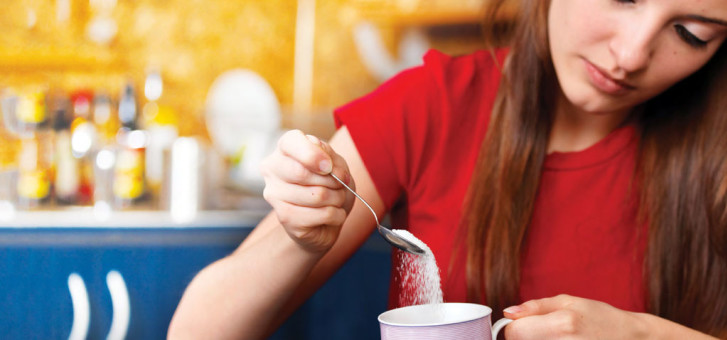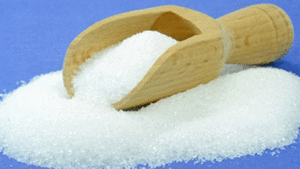On March 4, 2015, the World Health Organization (WHO) isued a new guideline, stating that adults and children in the Americas, Western Europe and the Middle East must roughly cut in half the amount of sugar they consume in order to lower their risk of obesity and tooth decay.
According to Dr Francesco Branca, the director of WHO’s Department of Nutrition for Health and Development, the current average sugar intake in South America is 130 grams per adult per day; in North and Central America it’s 95 grams per day; in Western Europe it’s about 101 grams per day; and in the Middle East it’s about 90 grams per day. Equatorial and southern Africa have the lowest average, at 30 grams per day.
A high intake of sugar leads to inflammation, which is the root cause of many chronic diseases. Immunity—the ability to fight off illness—is also lowered by a high sugar intake and the excess kilojoules associated with sugar can lead to weight gain and even obesity.
Sucrose, the table sugar you buy at the store, is composed of two other sugars: fructose and glucose. Fructose is found in slightly higher amounts in common sweeteners such as high-fructose corn syrup, which is used heavily in sweetened processed foods in North America.
Recent research shows that a high-fructose diet harms the brain as well as the body. An overconsumption of sugar can reduce factors linked to learning and memory, and can increase the risk of depression.
Fernando Gomez-Pinilla, professor of neurosurgery at the University of California, Los Angeles, explains it this way: “Eating a high-fructose [added sugar] diet over the long term alters your brain’s ability to learn and remember information. Eating too much high-fructose [food] could block insulin’s ability to regulate how cells use and store sugar for the energy required for processing thought and emotions.”
Sugary foods can also be addictive. Sugar can create an appetite for itself: the more sugar you eat, the more you want.
What’s the primary source of sugar in the Western diet? You probably guessed it: soft drinks. One can of soft drink contains about 33 grams of sugar. Even if you only have a can a week, that adds up to two kilograms of sugar per year! Lollies and the sugar that’s added to food and drinks contribute 16 per cent of the sugar we consume. The rest comes from fruit drinks, ice-cream and refined grains.
How much is too much?
Less is best when it comes to added sugars. A study from the American Heart Association cocluded that sugar should be limited to 25 grams per day for women and no more than 35 grams per day for men. If a person has challenges with blood sugar or high triglycerides, less than 16 grams is recommended per day.
So how much sugar is enough and how much is too much? The best plan is to remember the sugar consumption recommendations listed above. It’s true that honey, molasses and maple syrup may contribute some useful trace minerals, but they’re still sweeteners, so the amount consumed should still fall within the recommendations.
The best sweets are fresh fruits that have plenty of fibre and water. When you’re used to eating a lot of sweets and refined sugar, your taste buds get used to the high intensity of sweetness and fruit may seem less than inviting and “just not sweet enough.” However, after a few days of reducing the consumption of foods with added sugar, your taste buds will adapt and you’ll find that fruit is indeed delightfully sweet and satisfying.
So start eating more of the “good stuff.” Frequent the produce department at your supermarket. Enjoy a variety of colours in foods. Focus on beans, wholegrains and fresh fruits. Read labels. You’ll be surprised at just how quickly your sugar cravings can be quieted. When your body is getting the energy and nutrients it needs from whole foods, it’s less likely to have a strong craving for sugary ones. So work on the offence rather than chasing an addiction: eat healthful foods to ward off your body’s emergency cry for sugar.
How do I know how much sugar is in a product?
Four grams of sugar equals one teaspoon. On the food label under carbohydrates, you’ll see grams of sugar. Divide the amount of sugar in the product by four and that will tell you how many teaspoons of sugar are in the product.
For example, a label on a litre-sized soft drink may indicate that one serving has 33 grams of sugar. To calculate how many teaspoons that is, divide 33 by four and you’ll get approximately eight. That’s eight teaspoons of sugar in just one serving!
The next question is, How many servings are in the bottle? Youmay be surprised to know that a litre of soft drink contains four servings. (I guess you’re supposed to share it with three friends!) So if you drink the entire bottle yourself, you’ve consumed approximately 32 teaspoons of sugar—about one teaspoon of sugar per 30 millilitre.
Another way to determine the true sugar content in a product is to read the list of ingredients. Ingredients are listed by weight. The first ingredient listed is present in the largest amount. Some manufacturers will separate the sweeteners so that sugar doesn’t appear as the first ingredient. By separating the types of sugars, they’ll appear throughout the ingredient list and not as the first ingredient. Add them together.
Names that indicate sugar include brown sugar, white sugar, invert sugar, confectioner’s sugar, corn sweetener, corn syrup, high-fructose corn syrup, honey, sucrose, lactose, fructose, dextrose, glucose, honey, molasses and maple syrup. Read carefully, because many products include more than one sweetener.
Quitting Sugar
The “I Quit Sugar” eating plan has garnered a large following in recent years. Unlike what its name suggests, it isn’t about cutting all sugar out of your diet. Sucrose, the table sugar you buy at the store, is made up of two other sugars—fructose and glucose. The “I Quit Sugar” eating plan actually focuses only on avoiding fructose. The other half—glucose—is allowed, as are more complex carbohydrate sweeteners.
By reducing the consumption of sucrose, the plan eliminates a large range of processed foods from the diet, which can lead to better whole food choices.
At the same time, many of the recipes adhering to this diet include such ingredients as rice malt syrup, which, while not high in fructose, is still a sweetener and high in other forms of sugar. The insistence on avoiding fructose in all forms can also lead to the complete elimination of healthy foods that naturally contain fructose, such as whole fruits. Also, while reducing sugar in the diet is certainly not a bad thing, such a strong focus on only one component of the diet can lead to an overconsumption of other foods such as red meat, high amounts of which have been linked to increased rates of bowel cancer.
Cutting back on Sugar
Begin with what you already like. Start by eating more of the plant foods you already enjoy. Do you like rice and beans? Or rolled oats? Focus on eating more of these.
Eat a rainbow of colours. Protective plant foods with phytochemicals provide colour, flavour and texture; and they work to protect your body, brain and nervous system.
Start the morning off right. Fuel your body with a fibre-rich breakfast, such as rolled oats with fruit and walnuts, wholegrain cereal with soy milk or wholegrain toast with unsweetened peanut butter and banana slices.
Feature beans and greens at your meals. Explore popular dishes from ethnic groups around the world and you’ll find a variety of tasty ways to add beans to your meals. Also, try combining greens and beans in a salad. For example, top a leafy green salad with chickpeas for extra flavour, nutrition and fibre.
Make your children a part of meal planning. Your kids won’t eat vegetables? Involve them in shopping for produce and helping to prepare food in the kitchen. You’ll be surprised at what they’ll eat when they’re involved.
Be prepared. Stock your kitchen with healthful plant foods so you’ll have something on hand for quick and easy meal preparation.
Written by Vicki Griffin and Evelyn Kissinger






